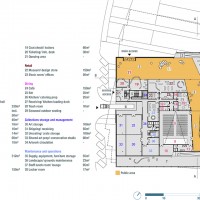The Guggenheim Helsinki looks to the past for a language that points towards the future. The shape of the building is the result of a design method in which the ramps, besides organising access to the various exhibition galleries, shape the space of the two atria. The ramps refer the image of the building to a myriad architectural references at once discordant and complementary: on the north and south facade, they allude to the ramps of a ziggurat, the terraces of a mastaba, the spirals of a minaret – and to Frank Lloyd Wright’s Guggenheim Museum. On the south facade, the ramps expand the space of the main atrium – the point of entry from which the geometry of the museum is organised. This geometry is, essentially, made of a suite of ramps that open gradually and operate dislocations in a dynamic overlapping of arches, thus creating a building that unfolds from its own logic whilst exerting a strong presence on the cityscape.
Some excerpts of the project description:
Exhibition Galleries
Obeying a system of circulation in which the relationship between the ramps and the galleries’ storeys is quite clear, the sculptural form of the museum functions as a translation of its own logic. Both complexes of ramps work in unison, allowing a clear and didactic movement through the exhibition galleries. The various exhibition floors are achieved as one walks the ramps of the two atria, with each flight leading onto a given exhibition story. The visit can also be conducted top-down, with the visitor starting from the panoramic elevators in the main lobby.
Plans
The GH ground floor is where the main maintenance, operations and amenities (café and shop) are found. The atrium can host events and performances that can be watched from the staggered ramps. The administrative and curatorial offices, both on the second floor, overlook the main atrium. The store is spread on the ground floor and on the fifth floor, while the restaurant is on the top floor.
Square
Marked by benches overlooking the sea and the South Harbour, the GH square is an open field of wooden flooring permeated by beds of tundra and integrated with the city centre and the harbour. In the summer, this space will be endowed with a colourful and varied vegetation and will invite Helsinki to relax and enjoy the views of Etaläsatama and its waterfront. To the north, the square gets a walkway that connects the museum to the Tahititornin vuori park.










